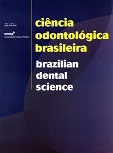Análise da efetividade da instrumentação associada à Terapia Fotodinâmica Antimicrobiana e medicação intracanal na eliminação de biofilmes de Enterococcus faecalis em canais radiculares
DOI:
https://doi.org/10.14295/bds.2010.v13i1/2.11Resumo
RESUMO
A eliminação total dos microrganismos dos canais radiculares é um procedimento de dificuldade extrema. O objetivo deste estudo foi avaliar in vitro a efetividade da instrumentação associada à terapia fotodinâmica na eliminação de Enterococcus faecalis ATCC 29212 nos canais radiculares. Foram utilizadas 20 raízes dentárias humanas que foram contaminadas com Enterococcus faecalis (incubação 14 dias). Após 14 dias, foi realizada coleta do conteúdo intracanal que foi semeada em meio de cultura TSA. Os canais foram instrumentados e preenchidos com associação do corante azuleno 25% e Endo-PTC durante 5 minutos e irradiados com laser ArGaAl por 3 minutos, somente no grupo teste. Outras duas coletas foram realizadas, sendo uma imediatamente e outra após 7 dias da terapia fotodinâmica, onde receberam medicação intracanal (polimixina B com clorexidina gel 2%) por 14 dias. Uma última coleta foi realizada após 7 dias da remoção da medicação. Os dados obtidos foram submetidos à análise estatística Mann-Whitney (5%). Concluiu-se que a instrumentação associada a Terapia Fotodinâmica Antimicrobiana frente a Enterococcus faecalis foi efetiva, mas não eliminou totalmente o biofilme intracanal monoespécie. Foi possível concluir também que a utilização da medicação intracanal de clorexidina gel 2% associada a polimixina B apresentou significativa efetividade sobre Enterococcus faecalis.
Downloads
Downloads
Arquivos adicionais
Publicado
Como Citar
Edição
Seção
Licença
TRANSFERÊNCIA DE DIREITOS AUTORAIS E DECLARAÇÃO DE RESPONSABILIDADE
Toda a propriedade de direitos autorais do artigo "____________________________________________________________________" é transferido do autor(es) para a CIÊNCIA ODONTOLÓGICA BRASILEIRA, no caso do trabalho ser publicado. O artigo não foi publicado em outro lugar e não foi submetido simultaneamente para publicação em outra revista.
Vimos por meio deste, atestar que trabalho é original e não apresenta dados manipulados, fraude ou plágio. Fizemos contribuição científica significativa para o estudo e estamos cientes dos dados apresentados e de acordo com a versão final do artigo. Assumimos total responsabilidade pelos aspectos éticos do estudo.
Este texto deve ser impresso e assinado por todos os autores. A versão digitalizada deverá ser apresentada como arquivo suplementar durante o processo de submissão.




























